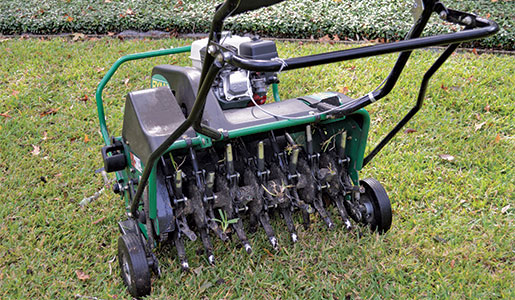
5 Benefits of Aerating Your Lawn
September 21, 2018One of the most beneficial treatments you can provide for your lawn is aeration. Core aeration is the process of removing small plugs of soil from the lawn, which reduces the compaction of your soil and promotes root growth. This is the preferred method among landscape professionals like Hively; the alternative, spike aeration, simply pokes holes, which is much less effective and can actually cause further soil compaction.
In the fall, when your turf switches gears from top growth to root growth, aeration provides water and nutrients better access to these roots, which helps it grow thicker and healthier. If you overseed this time of year, aeration also helps maximize soil-to-seed contact, which means you’ll be seeing more of your freshly planted seed sprouting.
If you’re considering aerating your lawn, there are several benefits we want to bring to your attention that may help illustrate the importance of this service.
It improves your turf’s overall health
Strengthening the root zone and providing better access to air, water, and fertilizer allows your grass to get everything it needs to grow and be healthy. The grass roots are able to stretch and grow and become even denser with soil aeration.
It reduces soil compaction
Aeration reduces the soil’s density and improves the air exchange between the soil and atmosphere. When the soil is too compacted, it deprives your turf’s roots of necessary air circulation. Aeration unclogs the compacted soil, which reduces dead spots, patches, and thinning caused by root “suffocation”.
It can reduce puddling or runoff
Loosening the soil with aeration also allows your lawn to better absorb water. If your lawn has spots that regularly see puddling during storms, or if there are spots where your yard has runoff, soil aeration may help with these problems.
It can reduce thatch
Thatch is a thin layer of decomposing organic matter on your lawn’s surface. While typically beneficial for your lawn, it is possible to have too much of a good thing. Ideally, thatch is less than ½ inch thick; otherwise it can prevent air, water, and nutrients from getting to your turf’s roots. Aeration helps break up this excessive thatch build-up and allows important nutrients and water into the soil.
It prepares your lawn for the future
Fall aeration helps prepare your lawn for its winter dormancy. When combined with overseeding, it can help improve your lawn’s resistance to disease and insects. As the lawn thickens, it can also crowd out weeds, making for a smoother, cleaner-looking lawn.
Even though your lawn may appear to be slowing down in the fall, your efforts this time of year make a lasting impact. Fall aeration strengthens your turf’s roots, making it hearty and healthy next spring and for years to come.
If you’re interested in aeration and aren’t sure where to start, give the lawn care experts at Hively a call at 717-292-5696 and we’ll be happy to help!